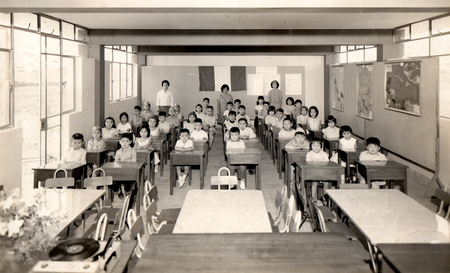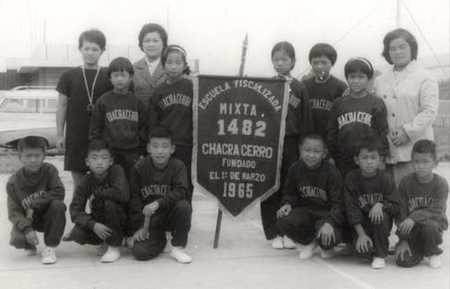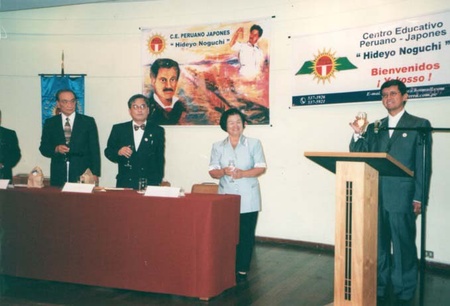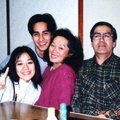His first student was his mother, an Okinawan immigrant. When she was a high school student, Juana Miyashiro discovered that her mother could not read Latin characters and became her literacy teacher.
It was the 1950s, embers of the war still lingered and the Peruvian government vetoed the entry of Japanese immigrants. However, their relatives in Peru had found a way to get around xenophobia: to make them enter surreptitiously through Bolivia.
Those Japanese who had recently arrived clandestinely in Peru were the next Spanish students of the teenager Juana. Thus, little by little, his house was transformed into a kind of school.
With this background, the fact that when he finished high school he decided to study education was a no-brainer. He did it at the Catholic University, defying his parents, who wanted him to choose pharmacy, a career that was in vogue at the time and that offered the possibility of having his own business.
KACHIGUMI CHILDREN TEACHER
Following his heart was a wise decision. Around six decades of teaching career support her. But as much or more than the numbers, she is supported by the recognition and gratitude of the multitude of students she trained from the 1960s to the 2020s.
He recently met up with an artist living in Australia, a former student, who visited Lima. She also mentions a former president of the Peruvian-Japanese Association who greeted her with affection during an event and who reminded her that she had been her sensei.
There were so many people he shaped, it is impossible to remember them all. But what remains intact, armored against the erosion of memories, is the feeling of pride every time a former student expresses their affection. “It was worth it,” he thinks.
It was worth the arduous effort to educate, an apostolate that meant sacrificing time with the family, summoning infinite patience to care for a swarm of children, arming oneself with tenacity to not succumb to the problems that occurred without pause, realizing that almost as important as teaching is managing.
Yes, manage, because that was what Juana Miyashiro started doing from a very young age, just graduated from university. She has been both a teacher and an educational entrepreneur.
His first job destination was the district of Puente Piedra, where some Spanish nuns opened a school. She, in addition to being in charge of a classroom, was in charge of carrying out all the bureaucratic procedures necessary for the opening and operation of the school.
He also went from house to house, knocking on doors in search of students for the new school. This is how he met families of Japanese origin who lived in the area.
The young Juana discovered among the Issei several kachigumi, Japanese who denied Japan's defeat in the Second World War and hoped to return to their homeland.
The Kachigumi were opposed to their Nisei children being part of the Peruvian educational system. “If we are going to return to Japan, why are they going to study in Peru?” they said.
The sensei was trying to convince them to allow them to study, but it was difficult. However, he did not give up. Taking advantage of the fact that the boys went to the market alone on Saturdays and Sundays to sell vegetables, she would call them to secretly teach them in a house that the religious congregation had in Puente Piedra.
While the Kachigumi were reluctant to integrate their children into Peruvian society, Juana's parents, like the vast majority of Issei who accepted the defeat of their country and had decided to put down roots permanently in Peru, wanted their children to will form as Peruvian citizens.
The bad thing about that was that the transmission of the Japanese language to the children was interrupted. To Juana Miyashiro, raised during the post-war period, her parents did not speak Nihongo to her, so she did not learn it, unlike her older siblings, born before the war.
Japanese was banned in his home and Spanish took over as the dominant language. Her mother was strict with her, she wanted her daughter to express herself in impeccable Spanish, without a Japanese accent, that she pronounced the “r” well, and she supervised that she did not make errors of agreement or gender when she spoke.
“HIDEYO NOGUCHI HAS TO BE THE NAME OF THE SCHOOL”
Thanks to her work in Puente Piedra, the sensei met many Japanese families from the Chacra Cerro urbanization, located in the neighboring district of Comas. Every day parents made long trips to take their children back and forth between school and home.
One day they invited her to Chacra Cerro, where there was a cooperative that brought together Japanese farmers and which also had a location available. “Why don't you start a school?” he suggested to the Issei in the area. Thus, they would no longer have to make extensive trips for their children to receive a formal education.
The parents asked her if she could help them with the efforts to create a school.
With the experience gained in founding the educational center of the Spanish nuns, Juana Miyashiro embarked on a new venture that led her to be founder and director of the Chacra Cerro school.
It was the mid-1960s and the school opened its doors with several dozen Nikkei students. The dissemination of Japanese culture was one of its pillars, a capital issue for the sensei; It was a personal challenge, since the transmission of nihongo had been cut off in his house due to the war.

He ran the Chacra Cerro school for more than 20 years, until it closed at the end of the 1980s, one of the worst times in Peru's history, marked by terrorism and the economic crisis.
The country seemed like a wasteland in which it was impossible for anything to grow (except the plagues that plagued it). Juana Miyashiro, however, did not lower her arms. Reality advised against throwing herself into the ring, but she, in the middle of the storm, went sailing again and opened a new school: Hideyo Noguchi.
“I had a moral obligation to continue,” he says. For the students and teachers of Chacra Cerro who without Hideyo Noguchi would have been left in the dark, for the parents who encouraged her to build another school.
How did the name come about?
One day he went to the Japanese Peruvian polyclinic and saw a photo of Hideyo Noguchi. Who is that man? Why is his image there? he wondered.
He searched for information about him, but didn't find much. He learned that Noguchi had been to Peru and Ecuador, and a friend who lived in this country sent him information.
He read about the difficult life of the Japanese doctor, his tenacious battle against yellow fever, and light came. “Hideyo Noguchi has to be the name of the school,” he said to himself.
Because?
“Youth are going to learn that things are not achieved easily, that they have to fight for it,” he explains.
The sensei decided to make Noguchi a model for her future students. A hero, but not those fictional ones, immaculate and shiny, but a real one, with chiaroscuro, with defects that humanized him.
A verse by the Spanish poet Antonio Machado, “the path is made by walking,” was another of his beacons.
The inauguration of the Hideyo Noguchi was special for the sensei because her parents attended it. “They didn't believe in me,” he remembers with a bit of sadness. But there they were both, proud of their daughter, of how she had transformed a dream into a school built from head to toe by her.
“THE GOOD FILM”
The Hideyo Noguchi school operated for more than 30 years, until the pandemic. In addition to instilling in his students the idea that to achieve goals you have to work hard (the fruits do not fall from the sky), he was concerned about their moral formation, so that they were not necessarily the first, but rather "the good guys in the movie." .
Being a good person implied, among other things, unity and camaraderie (“helping each other wherever they are”).
Order and cleanliness were substantial. As in Japan, the students cleaned the classrooms, they had to leave them as they had found them. At lunch time, they served food.
“Everything with love, nothing by force,” was a motto that also guided the school so that the students “did things with pleasure.”
At Hideyo Noguchi, teaching had a strong practical component. They taught you subjects that would be useful to you later in life - in line with the demand of the labor market at the time and your environment - such as shorthand, typing, shoemaking, etc.
He also prioritized art (music, painting, etc.). And although he promoted Japanese culture among his students, they did not grow up in a Japanese bubble, since in parallel they cultivated Peruvian folklore.
Social awareness was another relevant subject. The students traveled to the provinces bringing help to people with material needs and to get to know Peru beyond Lima, an experience that could be valuable for their future work.
School delegations were also taken to Japan, so that the students could experience first-hand the theoretical background (Japanese culture and customs) acquired in the classes.
As a balance, the sensei emphasizes: the study plans change, even the technology (which is constantly renewed), but human training remains the same.
DISCOVERING THE NIKKEI
“I am Chalaca at heart,” says Juana Miyashiro. He was born in Huaral, north of Lima, but grew up in Callao, home of many Japanese families.
In Callao he joined the large community of Japanese origin. He discovered that it was a united collective, but also that there was rivalry between the Okinawans and the Issei of the rest of Japan, as well as the roots of an ancient practice: arranged marriages between Japanese parents to marry their Nisei children.
Juana was part of Juventud unida, a group made up of Nisei schoolchildren who did humanitarian work (they brought aid to the victims of a landslide) and social and cultural activities (outings, Mother's Day, vocational guidance talks, etc.).
It was his first foray into a Nikkei institution. Later he was a member of organizations such as the Nisei Callao Association and the Nisei University Association of Peru.
In those days, remember, the Nisei used to be the best students in the national schools. The Issei “were not loving,” but they injected the culture of effort and family attachment into their children.
And although nihongo was relegated in his house after the war, Japanese customs and food were maintained. In particular, the Uchinanchu sentiment has permeated several generations of his family. His daughter Neyde, also a teacher, is a good example of this.
20,000 THANKS
“Be grateful 20,000 times,” the sensei used to tell her students to sow gratitude in them, a value that Juana Miyashiro practices.
“Life has been very rewarding to me, I always give thanks,” he adds. He smiles soberly, a hallmark of his personality, and a sparkle in his eyes that radiates a mixture of inner peace, joy and nostalgia.
In addition to the recognition of her former students (“it is an award that one receives”), she feels gratitude for the “excellent teachers” who have accompanied her throughout her career, to the companies and people who contributed with their donations or other contributions. to the operation of her school, to the Pana Usa program that provided scholarships to almost 700 students, to the community media that always lent her a hand, as well as in a special way to her husband.
Fukushima ken, Hideyo Noguchi's homeland, cannot be missing from her list (incidentally, the fact that the school has contributed to making the Japanese doctor better known in Peru is a source of satisfaction for her).
In its more than three decades of history, three Fukushima governors visited the school; In addition, the school occupies a display case in a museum in the Japanese prefecture.
The gratitude extends “to the homeland, to Peru, which welcomed our parents,” and finally, “my eternal gratitude and admiration to the Issei who taught us to love Peru and formed a solid and prestigious community that makes us proud.” .
© 2024 Enrique Higa Sakuda









